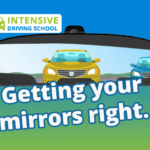With independent driving introduced to the practical driving test, it is very important you still remember the fundamental things you need to and should not be doing on your driving lessons and driving test! See our best practices to avoid driving test day nerves, it should be helpful to anyone taking a driving test.
Here are the 10 most common reasons why individuals fail their driving test:
1. OBSERVATION AT JUNCTIONS – MAKING A BAD DECISION BASED ON YOUR OBSERVATIONS
Prior to you get to the end of the road, you are required to currently be planning what you’ll do next. If it is an open junction (a junction at which, as you approach the pave the way lines, your view is not obscured by items such as high walls or hedges), try to see what is coming from BOTH directions. Make sure you look RIGHT, LEFT, and RIGHT once again, prior to driving out! It can be tempting if it looks clear, to just look right then drive out. DO refrain from doing this. It is easy to miss out on something on your left, such as a parked van, or potentially another vehicle cutting the corner developing into the junction as you emerge. If your instructor doesn’t let you do it on driving lessons, do not do it on your driving test!
2. REVERSE PARKING – FAILING TO SEE APPROACHING TRAFFIC/ NOT CHECKING YOUR BLIND SPOTS
A lot of individuals go through blind spot checks robotically, simply moving their head, since they believe this is what examiners want to see. Well it isn’t. What they want to see is that you are completely familiar with what is going on around you. This is particularly true when you will trigger the front of your car to swing out into the road as you drive towards the kerb. You need to use your mirrors properly, and keep an eye on the locations you can’t see in your mirrors, watching for other road users who might be driving toward you. Look out for bicyclists too!
3. USE OF MIRRORS– NOT COLLECTING INFO FROM WHAT YOU SEE IN THEM OFTEN ENOUGH, OR FAILING TO ACT UPON WHAT YOU HAVE SEEN
An example of this would be driving past a parked bus. You drive around the bus without inspecting the door mirror initially. As you pull out, a motorcyclist passes you on your right side. This would usually cause a severe fault, as you might have caused the motorcyclist to swerve.
Remember, whether on your test or as a qualified driver, you should not cause other road users to SLOW, SWERVE or STOP at any given time.
4. REVERSING ROUND A CORNER – INEFFICIENT OBSERVATION OR ABSENCE OF CONTROL AND PRECISION
Numerous pupils fail to see traffic approaching from behind them, in the roads they are turning into. They swing the car out causing an obstruction to traffic driving on the major roadway.
5. INCORRECT USE OF SIGNALS– OFFERING MISLEADING SIGNALS, OR FORGETTING TO CANCEL THEM
An example of this would be leaving a right signal on after pulling over on the right, then pulling out again with the indicator stick still ticking.
6. MOVING AWAY SECURELY– INSUFFICIENT OBSERVATION
Generally speaking, this is not checking the road side (offside) blind spot prior to moving away.
7. INCORRECT POSITIONING ON THE ROAD– BAD LANE DISCIPLINE AT ROUNDABOUTS OR BEING TOO FAR INTO THE ROAD GOING ROUND A BEND
An extremely common serious fault, specifically on driving test routes with numerous roundabouts.
Be sure not to ‘cut across’ the roundabout, but follow the suitable lane completely around the roundabout. Frequently this fault emerges on technique to roundabouts where the left lane curves round to the left a little at the roundabout. The pupil is still looking right and does not guide the car with the curve, but remains straight, causing them to straddle the white dividing lines.
8. LACK OF GUIDING CONTROL– STEERING TOO EARLY, OR TOO LATE
This is most noteworthy when going into sharp corners. Striking the kerb is possible if this is refrained from doing correctly. Contrary to common belief, crossing your arms on a driving test will not trigger you to fail. The majority of individuals tend to lose complete control of the wheel when they cross their arms, which is why the fault is marked. It is great practice to utilise the pull-push steering strategy that you have been shown in your driving lessons, which minimises the chances of losing steering control.
9. INCORRECT POSITION FOR TURNING RIGHT– AT JUNCTIONS OR ON ONE-WAY STREETS
Lots of learner driver will drive in the left lane in a one-way street, forgetting that it is really one-way! Remember you can utilise either lane in a one-way street!
10. IMPROPER SPEED– SURPRISINGLY SPEEDING ON DRIVING TESTS IS STILL IN THE TOP TEN FAULTS
Whether on a driving test or when passed, never ever break the speed limit or travel too fast into a danger.
This likewise uses to driving too slow all the time. Driving well under the speed limit is simply as harmful and dangerous as speeding.






